Planning a trip can feel like the most exciting part of the adventure, even before you set foot out the door. The process of crafting your itinerary, imagining yourself in new locations, and anticipating incredible experiences is a unique thrill. As you delve deeper into the details of your travel plan, that sense of excitement and anticipation only grows. By the time your departure day arrives, you’re not just excited—you’re also confident. You know you’ve considered every detail, leaving no stone unturned in your preparation. Of course, travel is unpredictable. Plans might need to be adjusted, and unexpected bumps may appear along the way. But with thorough planning, you’re prepared for those possibilities, equipped with alternative solutions should the need arise. Trip planning is more than just booking flights and packing a suitcase; it’s about designing an unforgettable experience that resonates deeply within you. Whether you’re dreaming of a quick weekend escape or a long-awaited international vacation, a well-structured travel plan is essential for a seamless and truly enjoyable journey.
Let’s dive into a comprehensive guide on How To Plan Travelling, ensuring your next adventure is everything you’ve dreamed of and more.
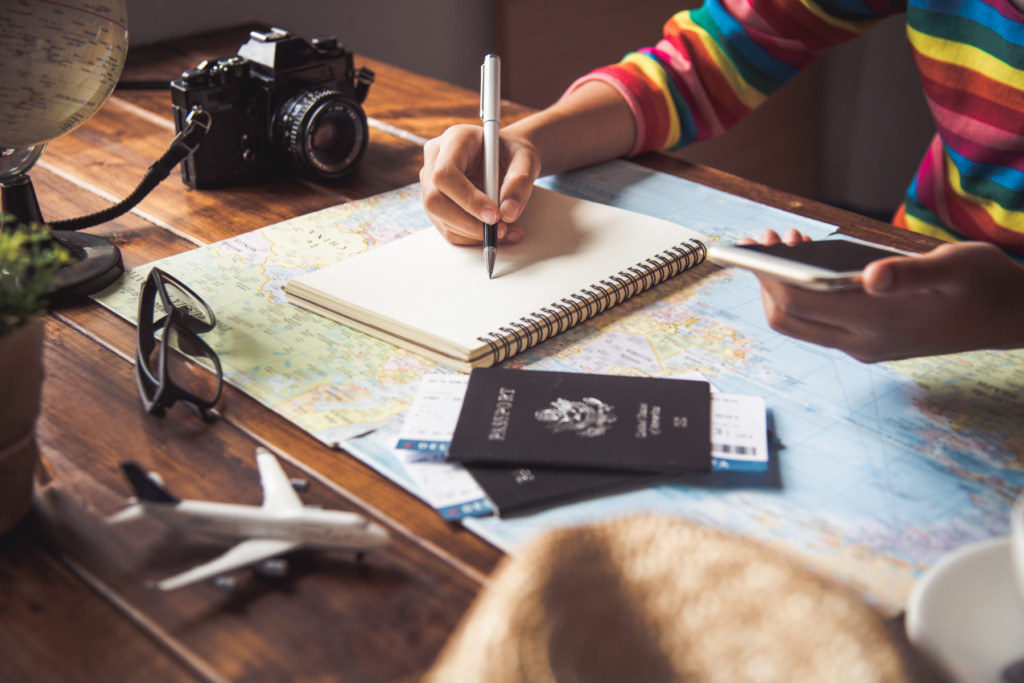 Person making travel notes surrounded by world map, passports, and camera
Person making travel notes surrounded by world map, passports, and camera
First Steps in Travel Planning
1. Understanding Different Planning Styles
It’s important to recognize that not everyone approaches travel planning in the same way, and that’s perfectly fine. Some people thrive on detailed itineraries and meticulously organized schedules, while others prefer a more spontaneous, go-with-the-flow approach. Imagine a couple: one partner, like myself, finds joy in the intricate details of planning, researching destinations, accommodations, and activities well in advance. The other might be more like my partner, Mark, who prefers to be surprised and enjoys the adventure of discovering things as they unfold. He trusts that I’ve got the essential details covered but prefers not to be bogged down with too many specifics until closer to the moment. He likes the spontaneity of being informed about the day’s plans on the morning itself, relishing the element of surprise.
If you identify more with Mark’s style but find yourself without a dedicated planner in your travel party, don’t worry. Even if you lean towards spontaneity, a basic travel plan is still advisable. It ensures you have the essentials covered, preventing potential travel mishaps like being stranded without resources or transportation. The good news is, there are numerous resources available to assist with even the most minimal planning needs, from user-friendly travel apps to customizable templates.
Whether you’re an Andrea, who loves diving deep into the planning process, or a Mark, who prefers a more laid-back approach, this guide will provide valuable insights and steps to make your travel planning effective and enjoyable.
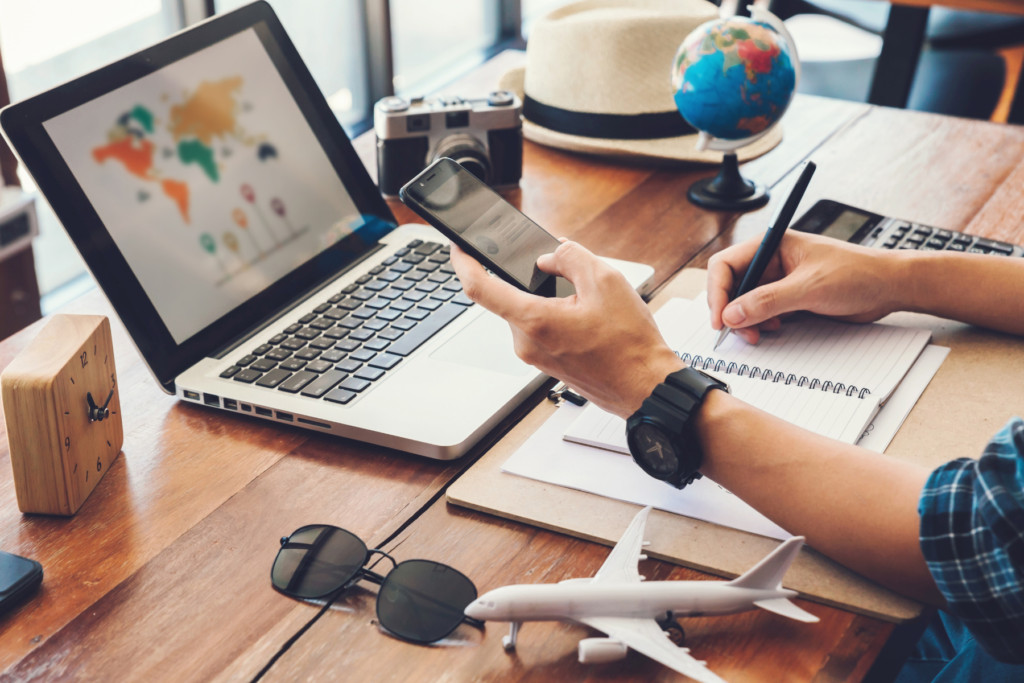 Person holding phone and looking at laptop while making travel notes
Person holding phone and looking at laptop while making travel notes
2. The Importance of Flexible Travel Plans
While detailed planning is beneficial, it’s equally important to build flexibility into your travel itinerary. Life is unpredictable, and travel plans can sometimes be disrupted by unforeseen circumstances. Rigidity can lead to stress and missed opportunities, whereas flexibility allows you to adapt and even embrace unexpected adventures.
Consider these common travel disruptions:
- Flight Cancellations or Delays: Airlines can cancel or delay flights due to weather, mechanical issues, or operational reasons. Having buffer time in your schedule and knowing alternative transportation options can be crucial.
- Political or Social Instability: Unexpected political events or social changes in a destination can impact travel safety and accessibility. Staying informed about current events and having contingency plans allows you to adjust your route or destination if needed.
- Weather-Related Issues: Severe weather, from hurricanes to blizzards, can disrupt travel plans significantly. Being prepared to alter your itinerary based on weather forecasts can save you from disappointment and ensure safety.
- Serendipitous Encounters: Sometimes the most memorable travel experiences arise from unplanned moments. You might meet a local who recommends a hidden gem, or get invited to a local festival you weren’t aware of. During our trip to Ethiopia, we were unexpectedly invited to a local wedding – an experience we would have missed if our itinerary had been too rigid.
Overplanning can sometimes lead to exhaustion and a feeling of obligation to stick to a packed schedule, even when you’d rather relax or explore something unexpected. Imagine pre-booking a guided tour only to find yourself wanting a peaceful beach day instead. Building in downtime and leaving room for spontaneity can lead to richer, more authentic travel memories.
When planning your trip, remember to incorporate free days or afternoons, consider flexible activity options, and avoid over-scheduling. Be open to spontaneous detours and unexpected invitations. Some of your most cherished travel memories will likely come from those unplanned, delightful surprises.
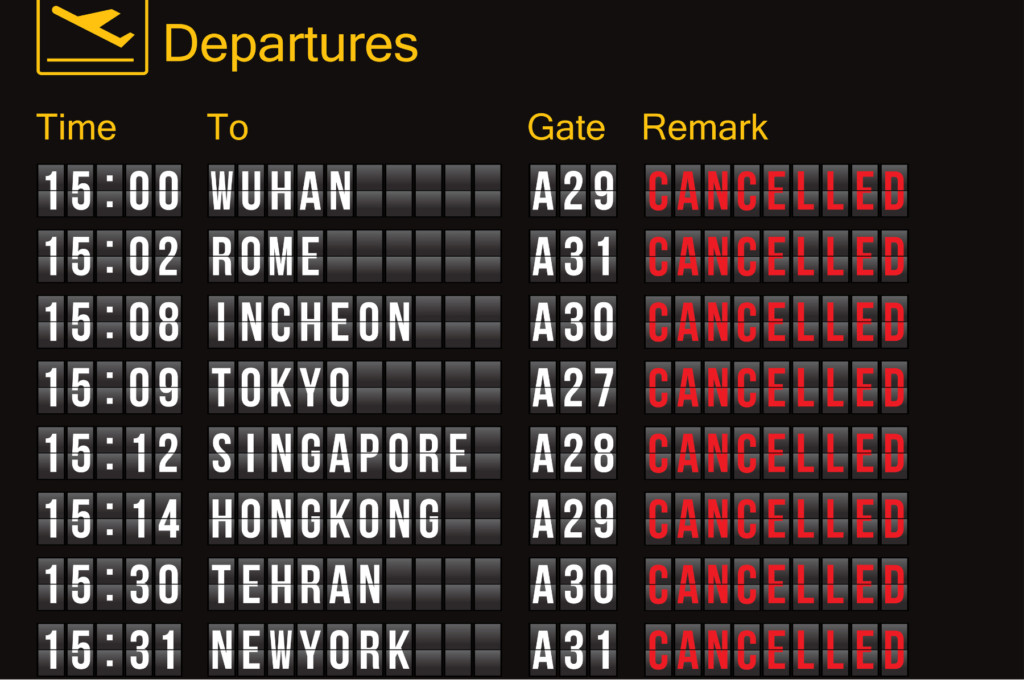 Airport departure board showing cancelled flights to various destinations
Airport departure board showing cancelled flights to various destinations
3. Overcoming Trip Planning Overwhelm
Embarking on trip planning, especially for first-timers, can feel overwhelming. The sheer volume of information available online, from destination guides to booking platforms, can be daunting. It’s easy to feel lost amidst endless options and details, leading to overwhelm or even procrastination. Staying focused and organized is key to managing this potential stress.
The feeling of being overwhelmed is common because:
- Information overload: The internet offers a vast amount of travel information, which can be both a blessing and a curse. Sifting through countless blogs, reviews, and websites to find relevant information takes time and can feel chaotic.
- Decision fatigue: From choosing a destination to selecting accommodations and activities, trip planning involves numerous decisions. This constant decision-making can lead to mental fatigue and make the process feel burdensome.
- Fear of missing out (FOMO): Travelers often worry about missing out on key attractions or experiences. This can lead to over-packing itineraries and trying to fit too much into a single trip, adding to the stress.
- Uncertainty and anxiety: Planning involves dealing with unknowns, such as navigating unfamiliar places, languages, and cultures. This uncertainty can trigger anxiety, especially for less experienced travelers.
To avoid feeling overwhelmed, it’s essential to break down the planning process into manageable steps. Following a structured approach, like the step-by-step guide outlined here, can provide clarity and direction. Focus on one task at a time, and celebrate small milestones along the way. This systematic approach transforms a potentially daunting task into a series of achievable actions, making trip planning feel less stressful and more enjoyable.
4. Choosing Your Travel Plan Format
As you progress through the trip planning process, you’ll accumulate a wealth of information – from accommodation bookings and flight details to lists of attractions and restaurant recommendations. This collection of details becomes your essential travel document, a guide you’ll refer to frequently throughout your journey. Therefore, deciding on the best format for this document before you start planning is a crucial first step.
Consider these options for recording your travel plan:
- Digital Trip Planning Apps: For tech-savvy travelers, numerous free trip-planning apps are available for smartphones and tablets. These apps, like TripIt, Google Trips (now integrated into Google Maps), or Wanderlog, offer features such as itinerary organization, offline access to information, real-time updates, and collaboration tools. Digital formats are convenient, easily searchable, and eco-friendly.
- Digital Documents on Your Phone or Tablet: If you prefer a customized digital approach without relying on apps, you can create digital documents using note-taking apps like Evernote, Google Docs, or Microsoft OneNote. These allow you to organize information into sections, embed links and images, and access everything offline. This method offers flexibility and personalization.
- Traditional Written Notebook: For those who appreciate a hands-on approach, a physical notebook remains a popular choice. A dedicated travel notebook allows you to jot down notes, sketch maps, paste printouts, and physically flip through pages. There’s a tactile satisfaction in writing and organizing your plans by hand. Choose a notebook with features like ribbon markers, an elastic fastener, and a pen holder for added convenience.
My personal preference leans towards the traditional notebook. I enjoy the tactile experience of writing, annotating, and physically organizing my plans. There’s something satisfying about flipping back and forth through a well-worn travel journal, filled with notes and annotations gathered during the planning process.
 A5 black notebook with ribbon markers and pens
A5 black notebook with ribbon markers and pens
Step-by-Step Guide: How to Plan Travelling
With the preliminary considerations addressed, we’re ready to embark on the step-by-step process of planning your trip. Let’s take it one step at a time to ensure a smooth and organized approach.
Step 1: Verify Your Passport Validity
It might seem unusual to begin trip planning by checking your passport, but if you’re travelling internationally, it’s absolutely essential. Passport validity issues are a common cause of travel disruptions, and addressing this first can save you significant headaches later.
Here’s why checking your passport is the crucial first step:
- Minimum Validity Requirements: Many countries require your passport to be valid for at least six months beyond your intended stay. This is to ensure that if your trip is unexpectedly extended, your passport remains valid for your return. Recently, some travelers have been caught out by this rule, especially if their passport was issued close to ten years ago. Even if the expiry date seems more than six months away, some immigration officers may consider the issue date. For example, in the UK, passports can be issued with validity exceeding ten years in some cases, so checking the issue date is crucial.
- Blank Passport Pages: Some countries, particularly in Africa and Asia, require a certain number of blank pages in your passport for entry and exit stamps, and for visas. If you are planning a multi-country trip, especially one involving regions known for visa requirements or numerous border crossings, ensure you have enough blank pages. Our recent seven-month trip across 13 African countries highlighted just how quickly passport pages can fill up!
- Stamps from Unfavored Countries: Be aware that stamps from certain countries can cause entry issues in others. For example, travelers who have visited Cuba recently may face restrictions when applying for an eVisa to the USA. Similarly, an Israeli stamp in your passport might prevent entry to some Middle Eastern countries. Even novelty stamps from tourist sites can sometimes raise concerns. In a notable incident in 2020, a traveler was denied boarding on a flight from Madrid to Thailand because a Machu Picchu stamp was deemed to have invalidated her passport by the airline.
- Passport Condition: A damaged or excessively worn passport might be rejected by immigration authorities. Tears, water damage, or a dog-eared passport could be deemed invalid. Ensure your passport is in good condition before you travel.
- Passport Renewal Time: Getting a new passport or renewing an old one can take longer than you might expect, especially during peak travel seasons. In the UK, for example, passport renewals can currently take up to ten weeks. Start the renewal process early to avoid last-minute stress.
- Visa Applications Requiring Passport Submission: While eVisas are increasingly common, some countries still require you to physically submit your passport for visa processing at an embassy or consulate. This means your passport will be unavailable for a period, so factor this into your timing, especially if you might need your passport for other reasons before your trip.
The key takeaway is to address your passport validity well in advance of any other travel planning. Ensure it is valid for long enough, has sufficient blank pages, is in good condition, and won’t cause any unforeseen entry issues.
 Example of a UK passport
Example of a UK passport
Step 2: Choose Your Destination
With your passport readiness confirmed, the next exciting step is to decide where you want to go. You might already have a dream destination in mind, a place you’ve longed to visit. Or, you might be open to suggestions and looking for inspiration. If you have a long bucket list like I do, prioritizing destinations becomes a key part of the decision-making process.
Factors to consider when choosing your destination:
- Budget: The cost of travel varies significantly between destinations. Research the average expenses for flights, accommodation, food, and activities in potential locations to ensure they align with your budget.
- Time Availability: The length of your trip will influence your destination choice. A short weekend getaway might be best suited for a nearby city or region, while a longer vacation allows for exploring more distant or multi-destination trips.
- Season and Weather: Consider your preferred climate and the best time to visit your potential destinations. Do you want sunny beaches, snowy mountains, or mild spring weather? Research the typical weather patterns for your travel dates.
- Travel Style and Difficulty: Think about the type of travel experience you’re seeking and your comfort level with different travel styles. Are you looking for adventure travel, cultural immersion, relaxation, or luxury? Also, consider the ease of travel within the destination. As we get older, we increasingly consider the physical demands of travel. We are planning more challenging destinations (like South America or Northern India) for now, while saving ‘easier’ destinations (like Australasia or Europe) for later.
If you’re undecided about where to go, start by asking yourself these questions:
- What kind of experience are you looking for? Relaxation, adventure, culture, nature, city exploration?
- What is your ideal trip pace? Fast-paced with lots of activities or slow-paced with ample downtime?
- What type of environment appeals to you? Beaches, mountains, cities, countryside, deserts?
- What activities are you interested in? Hiking, museums, water sports, historical sites, food tours, nightlife?
- Who are you travelling with? Solo, partner, family, friends? This will influence the type of destination and activities that are suitable.
- What is your ideal weather? Hot, cold, mild, dry, rainy?
- What is your budget for this trip? Be realistic about what you can afford.
- How long do you want to travel for? Weekend, week, month, longer?
- What are your must-have elements for a trip? Certain cultural experiences, specific foods, historical sites, natural wonders, or activities?
- How do you prefer to travel? Flights, trains, driving, cruising, cycling, walking?
Once you have a clearer idea of your preferences, start browsing online. Explore travel blogs, destination websites, and travel magazines. Search with an open mind and let yourself be inspired by unexpected possibilities. Finding destinations that match your criteria and interests is exciting. Once you find a destination that resonates with you, you’ll have a clear goal to work towards, making the rest of the planning process more focused and enjoyable.
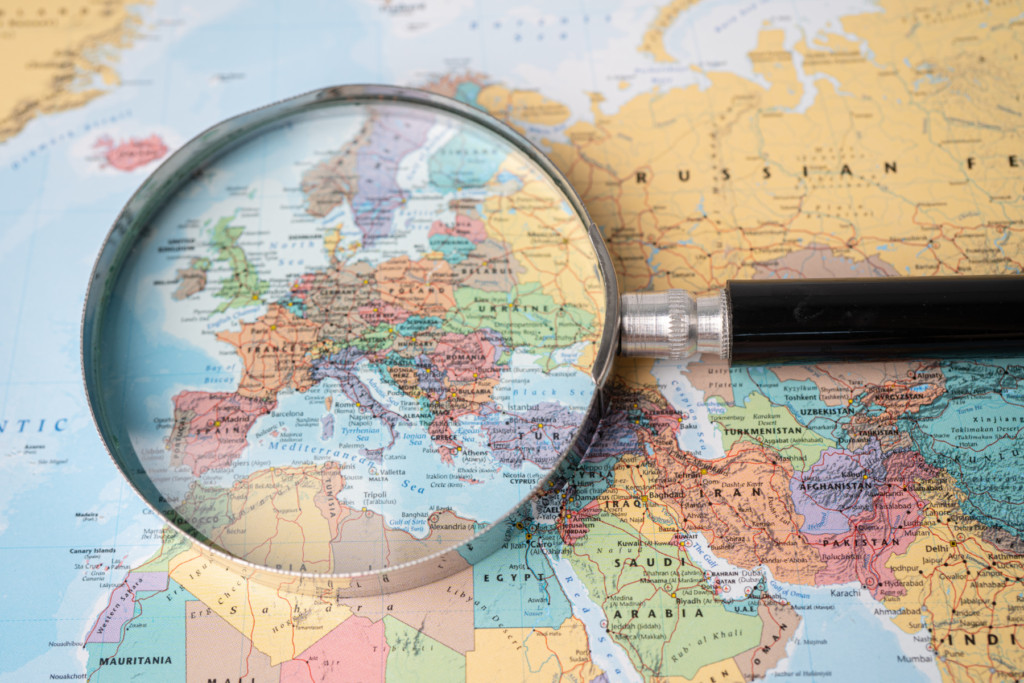 World map with magnifying glass over Europe
World map with magnifying glass over Europe
Step 3: Research Your Chosen Destination
With your destination selected, it’s time to delve into detailed research. Thorough destination research is crucial for informed planning and a richer travel experience. Start with broad online searches using search engines like Google to gather basic factual information. But go beyond surface-level details. Seek out independent travel blogs and websites like mine to gain anecdotal insights, insider tips, and authentic recommendations.
Focus your research on these key areas:
- Geography and Location: Use Google Maps to pinpoint your destination and understand its geographical context. Are there nearby countries or regions that could be combined into your trip? Are there other cities or towns within your chosen country worth exploring? Understanding the geography helps in planning logistics and potential side trips.
- Language and Communication: Find out the official language(s) spoken in your destination. Learning a few basic phrases in the local language can greatly enhance your interactions with locals and enrich your experience.
- Currency and Costs: Determine the local currency and research the cost of living. This will help you budget effectively for accommodation, food, transportation, and activities.
- Visa and Passport Requirements: Reconfirm the specific visa and passport requirements for your nationality and destination. Government travel advisories and embassy websites are reliable sources for this information.
- Climate and Best Time to Visit: Research the climate patterns and identify the best time of year to visit based on your weather preferences and planned activities. Consider factors like temperature, rainfall, and humidity.
- Culture and Customs: Learn about the local culture, customs, and etiquette. Understanding cultural norms shows respect and helps you navigate social situations appropriately.
- Religion and Social Norms: Identify the predominant religion(s) and understand any related social norms or customs that might impact your travel, such as dress codes or dietary restrictions.
- Festivals and Events: Check for local festivals, holidays, or special events that might coincide with your trip. Attending a local festival can be a highlight of your travel experience, but also be aware that major events can impact accommodation availability and prices.
- Safety and Health: Research any specific safety concerns or potential dangers in your destination. Check for travel advisories from your government. Also, investigate recommended vaccinations and health precautions.
- Must-See Attractions and Activities: Identify the main attractions, landmarks, and activities that appeal to you. Read reviews and travel guides to prioritize your sightseeing.
- Food and Drink: Explore the local cuisine and identify must-try dishes and drinks. Food is an integral part of cultural experience, and researching culinary highlights can enhance your trip.
For up-to-date and reliable information, especially regarding safety and travel advisories, refer to your government’s official travel advice website. For example, in the UK, the government website https://www.gov.uk/foreign-travel-advice is an excellent resource. Look for the equivalent site in your home country.
 Tablet showing Google search engine
Tablet showing Google search engine
Step 4: Set Your Travel Budget
Establishing a realistic budget is a fundamental step in trip planning. Your budget will influence many decisions, from destination choice to accommodation style and activity selection. Determine how much you are willing and able to spend on your trip.
When researching your destination (as in Step 3), pay attention to the cost of living and average travel expenses. A quick online search for “average cost of a stay in [your destination]” will provide numerous resources and articles to help you gauge expenses for different travel styles, from budget to luxury.
Your travel budget typically encompasses four main categories:
- Transportation: This includes flights, trains, buses, car rentals, taxis, and any other modes of transport you’ll use to reach your destination and get around. Flight costs can vary dramatically depending on the time of year, booking time, and airline. Internal transport costs will depend on the destination and your chosen mode of travel.
- Accommodation: Accommodation costs range widely from budget hostels and guesthouses to mid-range hotels and luxury resorts. Consider your preferred style of accommodation and research average prices in your destination.
- Sightseeing and Activities: Factor in the costs of entrance fees to attractions, guided tours, excursions, activities, and entertainment. Research prices for activities you plan to do in your destination.
- Food and Meals: Budget for meals, snacks, and drinks. Eating out at restaurants can be a significant expense, while self-catering or eating at local markets can be more budget-friendly. Consider a balance between dining experiences and cost-saving options.
Aim for budget flexibility:
- Flights vs. Experiences: While it’s tempting to allocate a large portion of your budget to flights, especially for long-haul destinations, ensure you leave enough for experiences at your destination. Don’t overspend on airfare if it means you’ll have limited funds for activities and sightseeing once you arrive.
- Internal Transport Options: For exploring a country or region, consider alternatives to internal flights, such as buses or trains. These options are often more affordable and offer a more immersive travel experience, allowing you to see more of the landscape and interact with locals.
- Accommodation Savings: Accommodation is often a significant part of the budget. While comfort is important, remember that your accommodation is primarily for sleeping. Consider mid-range or budget-friendly options to save money for experiences. Hostels, guesthouses, Airbnb, or budget hotels can offer substantial savings compared to luxury hotels.
- Self-Catering Options: If you want to save on food costs, consider self-catering accommodation with kitchen facilities. This allows you to cook some of your own meals, especially breakfast and lunch, and shop at local markets for fresh ingredients. This is not only budget-friendly but also a great way to experience local culture.
Don’t forget to include travel insurance in your budget. The cost of travel insurance depends on:
- Destination: Insurance for destinations like the USA or Caribbean is typically more expensive due to higher healthcare costs.
- Trip Length: Longer trips will generally have higher insurance premiums.
- Traveler Age and Health: Age and pre-existing health conditions can affect insurance costs.
- Coverage Level: The extent of coverage, including medical, cancellation, baggage, and personal liability, will impact the premium.
- Activities: If you plan to engage in risky activities like scuba diving or skiing, ensure your policy covers these.
Crucially, don’t allocate your entire budget. Always set aside a contingency fund for unexpected expenses, emergencies, or spontaneous opportunities that might arise during your trip. A safety cushion provides peace of mind and allows you to handle unforeseen situations without financial stress.
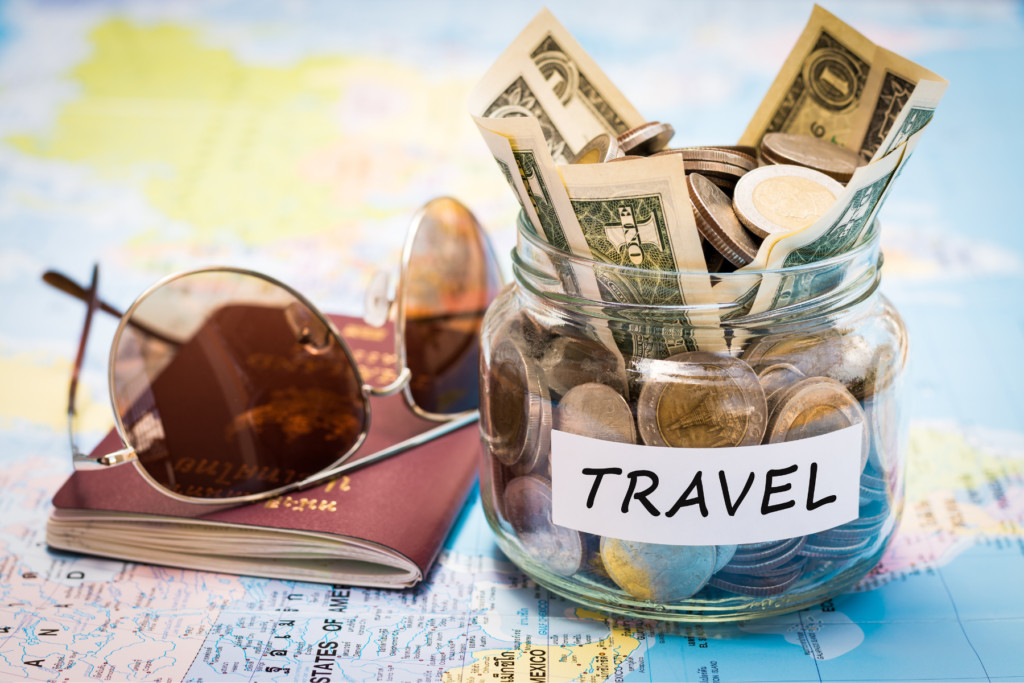 Jar of cash on world map with passport and sunglasses
Jar of cash on world map with passport and sunglasses
Step 5: Select Your Travel Dates
With your destination and budget in mind, the next step in how to plan travelling is to choose your travel dates. The timing of your trip can significantly impact your experience, from weather conditions and crowds to prices and events.
Base your date selection on these factors:
- Personal Availability: Consider your work schedule, vacation time, school holidays (if travelling with family), and any other personal commitments that might influence your travel dates.
- Preferred Season and Climate: Choose dates that align with your preferred weather in your chosen destination. Do you want to travel during the sunny summer, mild spring, colorful autumn, or snowy winter? Research the climate of your destination for different times of the year.
- Local Events and Festivals: Check for local festivals, events, or holidays that you might want to attend. Experiencing a major cultural event can be a highlight of your trip. However, be aware that travelling during peak festival times might mean higher prices and larger crowds. Conversely, you might want to avoid certain dates if there are events you’d rather miss, like crowded holidays. For example, my current South America trip planning is centered around being in Rio de Janeiro for Carnival and my 60th birthday – the timing of our arrival in Brazil is non-negotiable!
Before finalizing your dates, double-check for any travel advisories or restrictions that might be in place for your chosen period. Government travel websites will provide information on potential travel disruptions or safety concerns related to specific dates or regions.
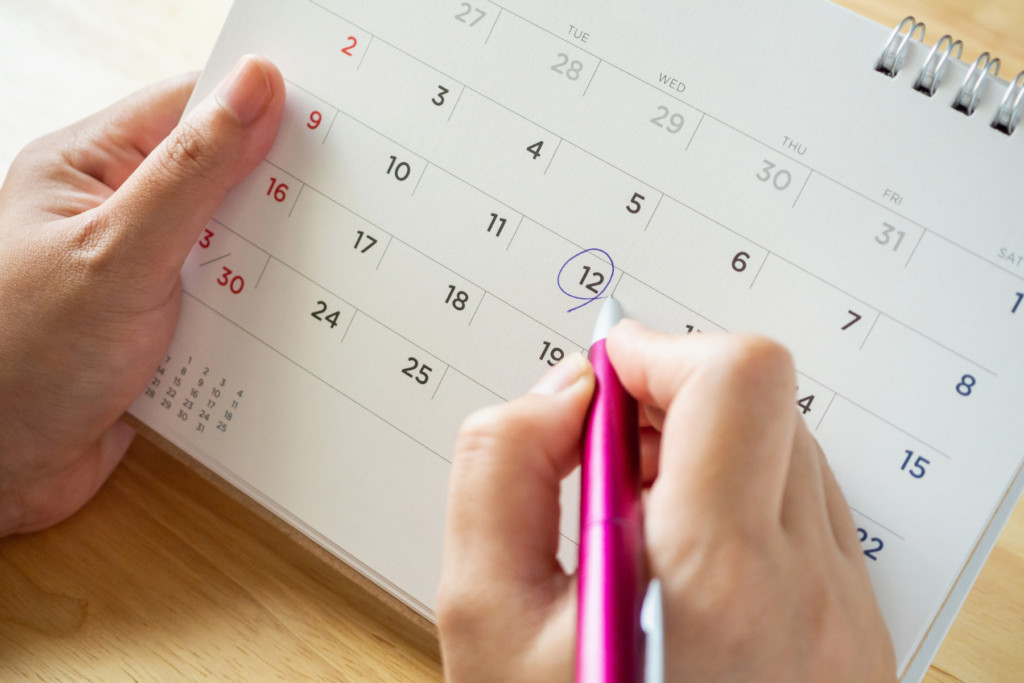 Person circling dates on a calendar
Person circling dates on a calendar
Step 6: Arrange Travel Insurance
While it might seem premature to think about travel insurance so early in the planning process, securing it at this stage is a smart move. Travel insurance is a critical safeguard against unexpected events that can occur before or during your trip.
It’s important to conduct thorough research to find the best travel insurance policy that meets your specific needs. Don’t simply opt for the cheapest option. Consider these factors when choosing travel insurance:
- Coverage Type: Ensure the policy covers medical emergencies, trip cancellation or interruption, baggage loss or delay, personal liability, and other potential travel mishaps.
- Coverage Amount: Check the limits of coverage, particularly for medical expenses and trip cancellation. Ensure they are adequate for your destination and potential risks.
- Activities Covered: If you plan to participate in adventure activities or sports, confirm that these are covered by the policy. Some standard policies exclude certain high-risk activities.
- Pre-existing Conditions: If you have any pre-existing health conditions, disclose them to the insurance provider and ensure they are covered or get a waiver if necessary.
- Policy Exclusions: Carefully read the policy exclusions to understand what is not covered.
- Customer Reviews and Claims Process: Research the insurance provider’s reputation for customer service and claims handling. A smooth claims process is crucial if you need to make a claim.
Purchasing travel insurance early, ideally soon after you start making bookings (like flights and accommodation), provides peace of mind. Should unforeseen circumstances arise between booking and your departure date – such as illness, injury, or family emergencies – your travel insurance can protect your financial investment.
Consider paying for flights and other significant travel expenses with a credit card that offers travel insurance as a benefit. Many premium credit cards include travel insurance, but always review the policy details to ensure it meets your needs.
If you have an annual travel insurance policy, carefully review its terms to ensure it covers the specific trip you are planning. Annual policies may have restrictions on trip duration, destination exclusions, or coverage limitations for certain activities.
Above all, never travel without insurance. The financial and logistical consequences of travelling uninsured can be devastating. Stories of uninsured travelers facing huge medical bills or losses due to unforeseen events are cautionary tales. I recall meeting a young solo traveler in Tobago who had decided against travel insurance to save money. Unfortunately, she became seriously ill and required medical evacuation to Miami, Florida. The costs incurred were astronomical and caused significant financial strain for her and her family.
Don’t be that traveler. Travel insurance is an essential part of responsible trip planning.
Step 7: Investigate Visa Requirements
Visa requirements vary significantly depending on your nationality and your destination. Understanding and addressing visa needs early in your planning is crucial to avoid last-minute complications or being denied entry.
While many countries now offer eVisas (electronic visas) or visa-on-arrival options, some still require traditional visa applications processed through embassies or consulates in your home country.
Here’s how to navigate visa requirements:
- Research Specific Requirements: Start by researching the visa requirements for your destination based on your passport nationality. Official government websites of the destination country and their embassy websites in your home country are the most reliable sources of information. Websites like https://www.visahq.com/ can also provide initial guidance, but always verify with official sources.
- Application Process and Timeline: Understand the visa application process. Does it require an online application, a postal application, or an in-person visit to an embassy or consulate? Application processing times can vary from a few days to several weeks, or even months in some cases. Apply well in advance of your intended travel dates to allow ample processing time.
- Required Documents: Prepare all necessary documentation for your visa application. Common requirements include passport validity (often six months beyond your stay), passport photos, proof of accommodation bookings, flight tickets (sometimes return tickets), financial statements to demonstrate sufficient funds, and a completed application form.
- Visa Types: Ensure you apply for the correct type of visa. Tourist visas are usually for leisure travel. If you intend to work, volunteer, study, or engage in other non-tourist activities, you will likely need a different type of visa. Single-entry visas allow only one entry into the country, while multiple-entry visas permit multiple entries within a specified period. Choose the visa type that matches your travel plans.
- Visa on Arrival (VOA): If your destination offers visa-on-arrival, understand the requirements and process. While convenient, VOA might have specific conditions, such as payment in cash (often in USD), specific passport validity, or proof of onward travel. Don’t assume you can pay by card for VOA; cash payment is often required, and it’s advisable to carry unmarked US dollar notes in case.
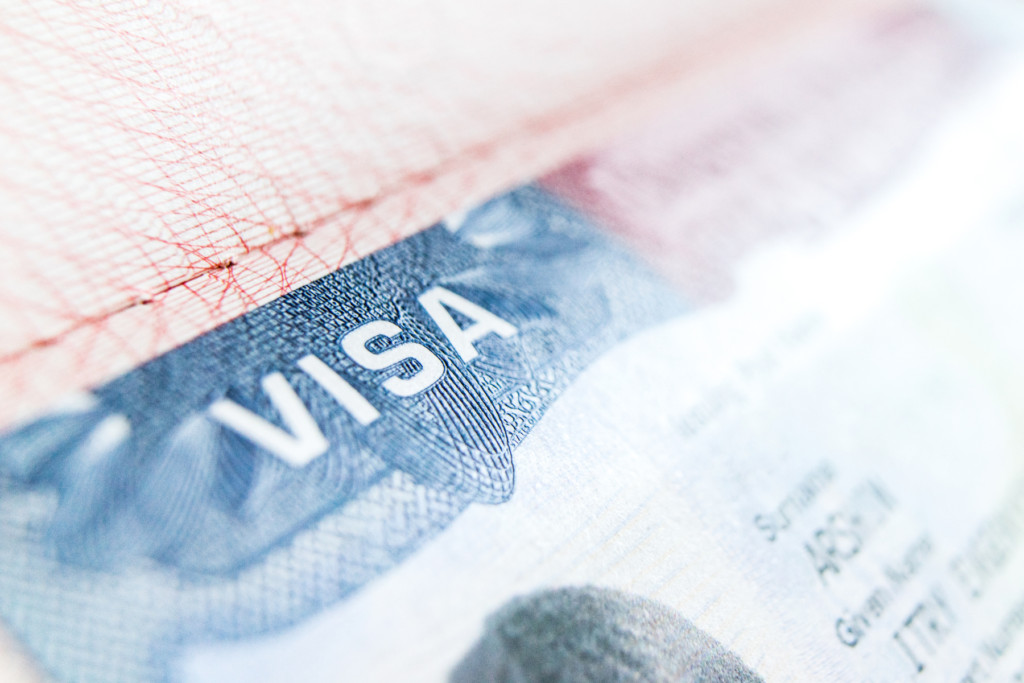 Visa stamp in a passport
Visa stamp in a passport
Step 8: Check Vaccination and Health Requirements
Protecting your health while travelling is paramount. Investigating and addressing vaccination and health requirements for your destination is a crucial step in trip planning.
Here’s how to approach health preparations:
- Research Recommended Vaccinations: Consult reliable sources to determine recommended and required vaccinations for your destination. The World Health Organization (WHO) website and your country’s travel health advisory websites (like https://travelhealthpro.org.uk/ in the UK or the CDC in the US) are excellent resources.
- Consult a Travel Health Professional: Schedule a consultation with a travel clinic or your healthcare provider at least 6 to 8 weeks before your departure. This timeframe allows vaccines sufficient time to become effective and for you to receive any necessary doses. A healthcare professional can provide personalized advice based on your destination, health history, and travel style.
- Vaccination Schedule: Follow the recommended vaccination schedule. Some vaccines require multiple doses administered over a period. Ensure you complete the full course before you travel to gain optimal protection.
- Antimalarials: Check if malaria is a risk in your destination and if antimalarial medication is recommended. Discuss antimalarial options with your healthcare provider, considering potential side effects and suitability for your health. We always take antimalarials when advised, having seen the severe consequences of malaria firsthand.
- Other Health Precautions: Discuss any other health precautions with your doctor, such as medications for traveler’s diarrhea, altitude sickness, or motion sickness, depending on your destination and planned activities.
- Travel Health Insurance: Ensure your travel insurance policy includes adequate medical coverage, including emergency medical evacuation if needed.
- Health Kit: Prepare a basic travel health kit with essentials like pain relievers, antiseptic wipes, bandages, diarrhea medication, insect repellent, sunscreen, and any personal medications you require.
Don’t neglect vaccinations due to cost concerns. Factor the cost of vaccinations into your travel budget. If you cannot afford necessary health precautions, consider choosing a different destination where health risks are lower or vaccinations are less extensive. Ahead of our seven-month African trip, we faced a significant bill to update our expired vaccinations, but we considered it a non-negotiable health investment.
 Woman getting travel vaccinations
Woman getting travel vaccinations
Step 9: Book Your Transportation
Booking transportation is a critical logistical step in trip planning. Whether you’re flying, driving, taking trains, or using other modes of transport, booking in advance is generally advisable, especially for flights and long-distance travel.
Transportation options are diverse and choosing the right mode depends on your destination, budget, time constraints, and travel style.
- Flights: For international travel and long distances, flying is often the most practical option. Booking flights in advance, especially for popular routes or peak seasons, can secure better prices and availability.
- Trains: Trains are a comfortable and scenic way to travel, particularly in Europe and parts of Asia. Rail passes can offer cost-effective travel for multi-city or regional journeys.
- Buses: Buses are often a more budget-friendly option for intercity and regional travel, especially in regions like South America, Asia, and Europe.
- Car Rentals: Renting a car provides flexibility to explore destinations at your own pace, particularly for road trips or visiting areas with limited public transport.
- Ferries and Boats: For island destinations or coastal regions, ferries and boats are essential modes of transport.
- Local Transport: Consider local transport options at your destination, such as metros, trams, buses, taxis, or ride-sharing services. Researching local transport in advance helps with planning your daily movements.
For flights, my go-to starting point is Skyscanner (https://skyscanner.pxf.io/c/4176429/1789303/13416). It’s a powerful flight comparison website that searches across numerous airlines and travel agents to find the best deals.
Tips for using Skyscanner effectively:
- Book in Advance: Start searching for flights as early as possible, ideally several months before your travel dates, especially for international flights and peak travel periods.
- Flexibility with Dates: Be flexible with your travel dates if possible. Even shifting your departure or return date by a day or two can sometimes result in significant savings. Use Skyscanner’s “whole month” view to compare prices across different dates.
- Price Alerts: Set up price alerts for your desired routes on Skyscanner. You’ll receive email notifications when prices decrease, allowing you to book at the optimal time.
- Consider Departure and Arrival Times: Don’t just focus on the cheapest flight. Check departure and arrival times. Very early morning or late-night flights might be cheaper but could incur extra costs for airport transfers or overnight accommodation if they don’t align with your accommodation check-in times.
- Luggage Allowance: Carefully check the luggage allowance included in the fare. Budget airlines often have very restrictive baggage policies, and adding checked baggage later can be expensive. Factor in baggage costs when comparing flight prices.
- Cancellation and Amendment Policies: Review the airline’s cancellation and amendment policies before booking. Flexible fares might cost slightly more but offer greater peace of mind if your plans change.
- Seat Selection: Decide if you want to pay extra to reserve specific seats. If you’re travelling with companions and want to sit together, or if you prefer window or aisle seats, pre-selecting seats might be worthwhile. We usually check in online early to try and secure preferred seats without paying extra.
- “Everywhere” Search: Use Skyscanner’s “Everywhere” search function for destination inspiration. If you’re flexible about where to go, this tool can reveal surprisingly affordable destinations you might not have considered. I also use it to find alternative routes. For example, when direct flights to Johannesburg were expensive, using “Everywhere” revealed that flying to the Seychelles and then onward to Johannesburg was significantly cheaper and allowed us a bonus island stay!
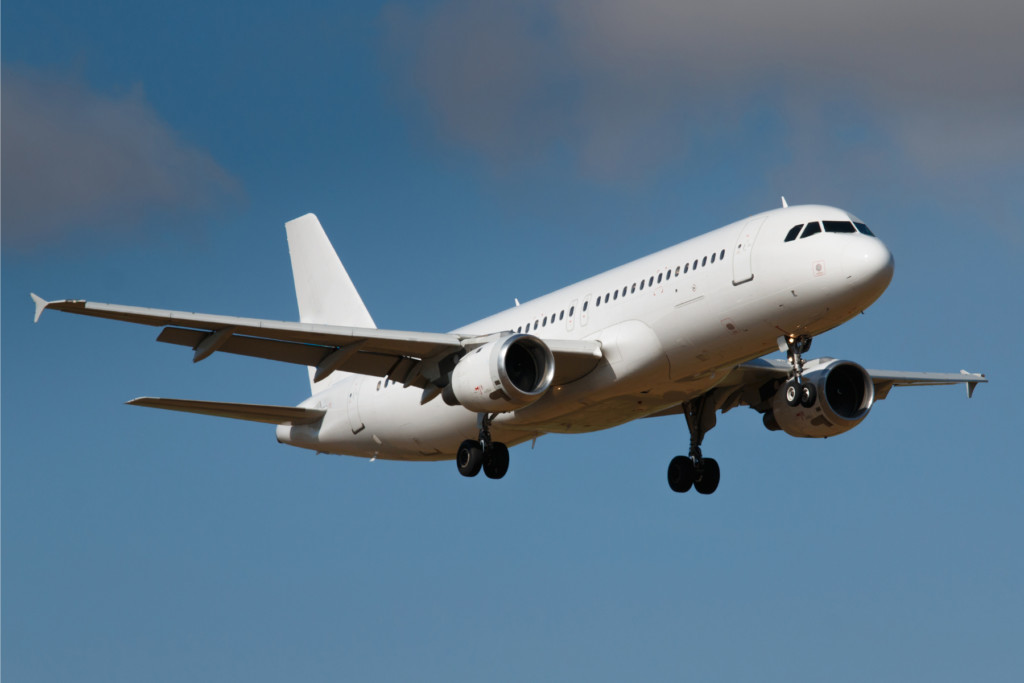 Airplane taking off
Airplane taking off
Step 10: Research and Reserve Accommodation
Choosing the right accommodation is a significant part of trip planning. Your accommodation serves as your home base during your travels, and the right choice can greatly enhance your comfort and experience.
Factors to consider when selecting accommodation:
- Budget: Accommodation costs can vary widely. Set a realistic budget for accommodation and stick to it. Explore options that fit your budget, from hostels and guesthouses to hotels and apartments.
- Location: Location is crucial. Consider whether you want to stay in the city center, near attractions, in a quieter neighborhood, or close to transport links. Central locations might be more expensive but can save time and transport costs.
- Type of Accommodation: Choose the type of accommodation that suits your preferences and travel style. Options include hotels, hostels, guesthouses, bed and breakfasts, apartments (Airbnb, VRBO), resorts, and campsites.
- Amenities and Facilities: Consider what amenities are important to you. Do you need free Wi-Fi, breakfast included, a swimming pool, gym, parking, laundry facilities, or accessibility features?
- Customer Reviews: Read reviews from previous guests on sites like Booking.com, TripAdvisor, or Google Reviews. Reviews can provide insights into the quality, cleanliness, service, and location of the accommodation. However, take reviews with a grain of salt and look for overall trends rather than focusing on isolated negative comments.
- Deals and Packages: Look for deals, discounts, or packages that might be available, such as free breakfast, extended stay discounts, or packages that combine accommodation with tours or activities.
- Booking Websites: Use reputable accommodation booking websites like Booking.com, Expedia, Agoda, or Hotels.com. Booking.com (https://www.booking.com/index.html?aid=1697858) is my preferred site due to its user-friendly interface, wide range of options, loyalty program (Genius Rewards), and flexible cancellation policies.
Booking accommodation in advance is generally recommended, especially during peak travel seasons or for popular destinations. Early booking secures your preferred choice and can often result in better prices.
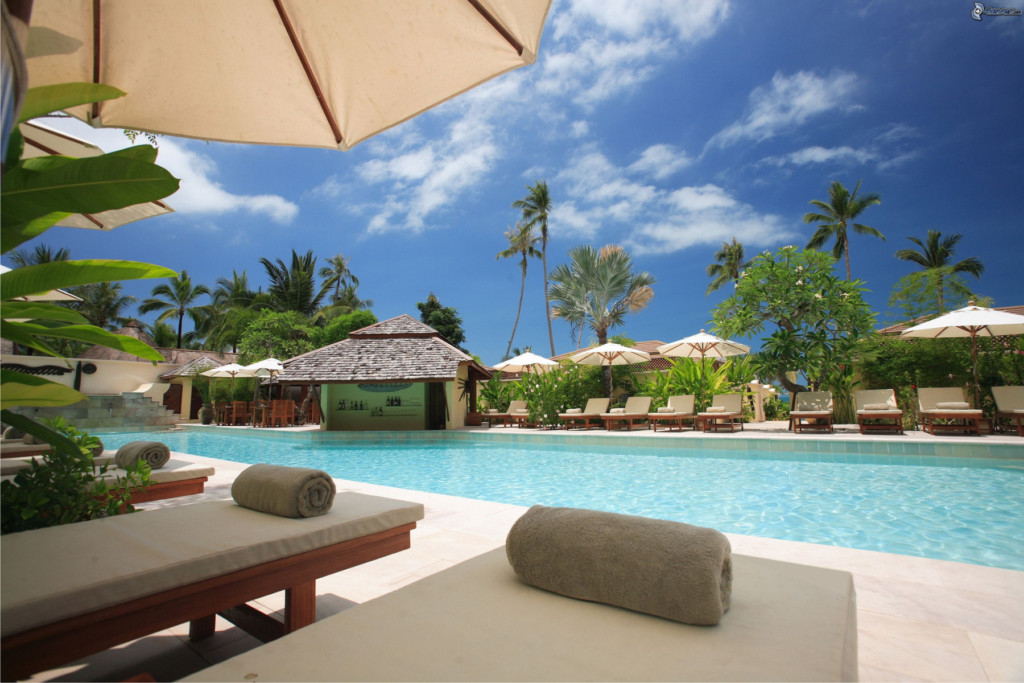 Swimming pool with sun loungers at a resort
Swimming pool with sun loungers at a resort
Step 11: Plan Your Activities and Tours
With the key logistics sorted, planning your activities and tours is the exciting stage where you shape your travel experiences. This is my favorite step! I love researching what to see and do in a destination.
Here’s how to plan your activities effectively:
- Identify Must-See Attractions: Use travel guides, websites, blogs, and recommendations to identify the “must-see” attractions and “must-do” activities in your destination.
- Prioritize Your Interests: Select activities that align with your personal interests, whether it’s history, art, nature, adventure, food, or culture. Don’t feel obligated to visit every popular attraction if it doesn’t genuinely appeal to you.
- Logistics and Accessibility: Consider the logistics of getting to attractions. Check opening hours, entrance fees, transportation options, and whether pre-booking is necessary or recommended. Factor in travel time between locations.
- Guided Tours vs. Independent Exploration: Decide whether you prefer guided tours or independent exploration. Guided tours can provide in-depth knowledge, insider access, and convenience, especially for historical sites or complex attractions. Local guides often offer valuable insights and recommendations. We always book a walking tour with a local guide when we arrive in a new city to get oriented and gather local tips. Independent exploration allows for more flexibility and spontaneity.
- City Passes and Discount Cards: Check if city passes or tourist discount cards are available for your destination. These passes often offer combined access to multiple attractions, public transport, and sometimes discounts on tours, often working out cheaper than paying for each activity individually.
- Activity Booking Websites: Use reputable activity booking websites like GetYourGuide (https://www.getyourguide.com/?partner_id=GUHG1Y3&utm_medium=online_publisher&utm_source=andrea%40happydaystravelblog.com&placement=content-end) and Viator (https://www.viator.com/?pid=P00169200&mcid=42383&medium=link) to research and book tours, activities, and experiences. These platforms offer a wide selection, customer reviews, and booking convenience.
- Balance and Downtime: Don’t overschedule your itinerary. Allow sufficient time to enjoy each activity without rushing and build in downtime for relaxation, spontaneous exploration, and simply soaking in the atmosphere of your destination.
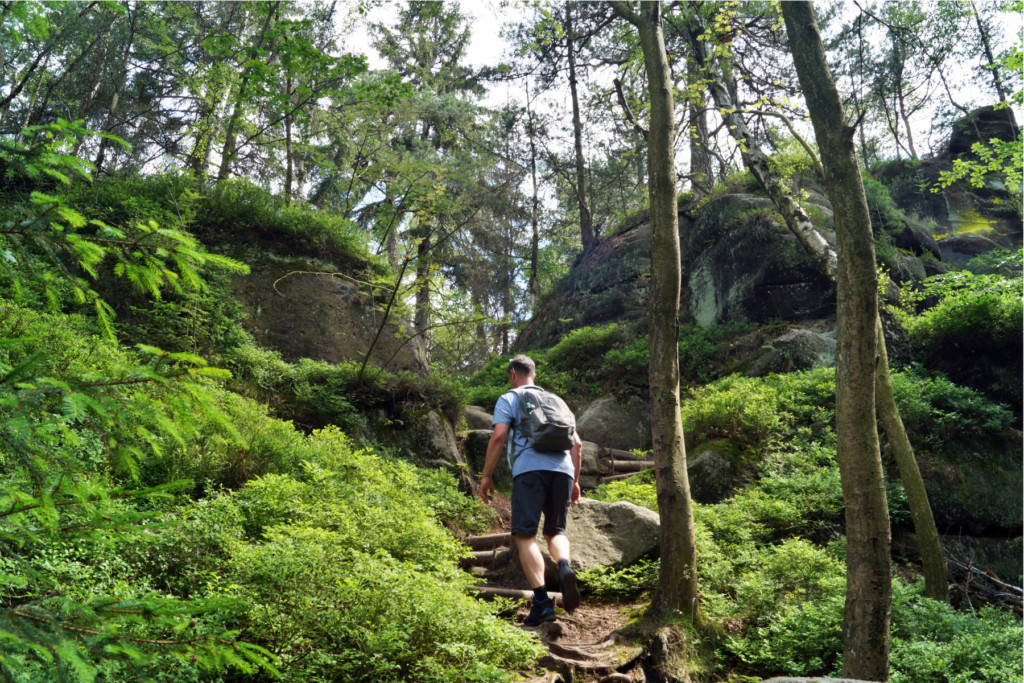 Man hiking on a forest path
Man hiking on a forest path
Step 12: Pack Smart and Efficiently
Packing efficiently is essential for comfortable and stress-free travel. Smart packing means taking what you need without overpacking, keeping your luggage manageable, and being prepared for your destination’s climate and cultural context.
Tips for packing smart:
- Make a Packing List: Create a packing list tailored to your destination, climate, planned activities, and duration of your trip. Start your list well in advance of your departure date.
- Check Weather Forecast: Review the weather forecast for your destination close to your departure date to pack appropriate clothing.
- Cultural and Religious Norms: Research any cultural or religious norms regarding dress codes in your destination. Some places may require modest dress, such as covering shoulders and knees, especially when visiting religious sites. Be aware of local customs regarding clothing appropriateness. In some countries, camouflage clothing is restricted or banned.
- Capsule Wardrobe: Plan a capsule wardrobe using versatile clothing items in neutral colors that can be mixed and matched to create multiple outfits. Choose lightweight, wrinkle-resistant fabrics.
- Essentials and Medications: Don’t forget essential items like prescription medications (pack enough for your trip plus a little extra, and carry a copy of your prescription), chargers and adapters for electronic devices, travel documents, and toiletries.
- Toiletries: For longer trips, don’t try to pack all the toiletries you’ll need for the entire duration. You can purchase most toiletries at your destination. Pack travel-sized essentials for the initial days and buy larger sizes locally if needed.
- Laundry: Plan for laundry. For longer trips, factor in doing laundry or using laundry services at your destination. Pack travel-sized laundry detergent or dryer sheets.
- Minimize Weight and Size: Choose lightweight luggage and aim to pack as light as possible. Overpacking leads to heavy luggage, which is cumbersome to carry and can incur extra airline baggage fees. Only take what you truly need and can comfortably manage.
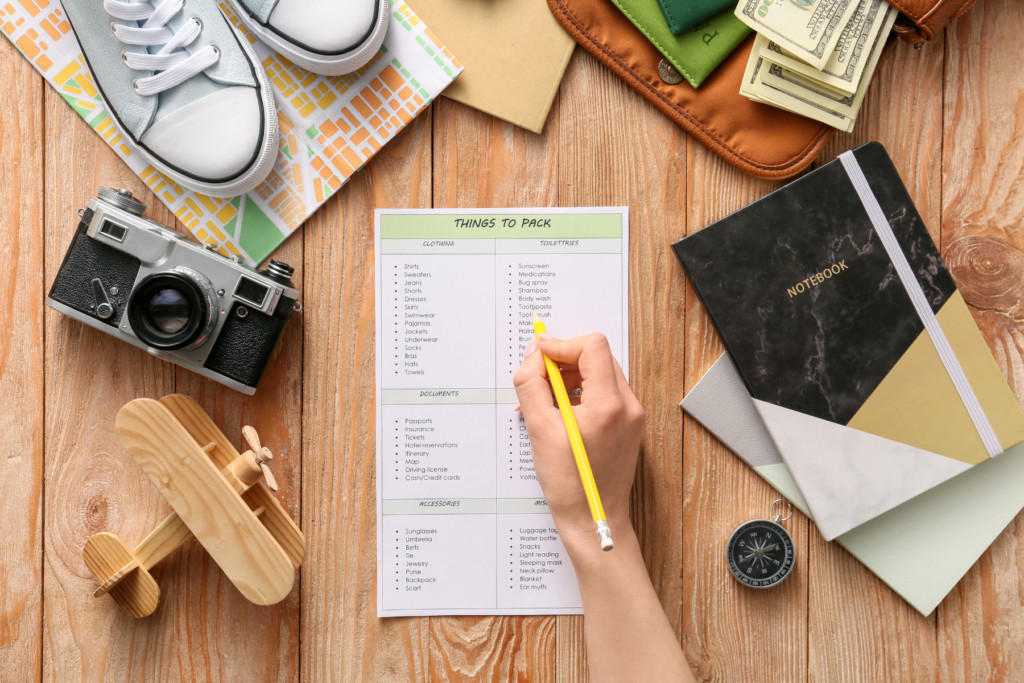 Person ticking items off a packing list
Person ticking items off a packing list
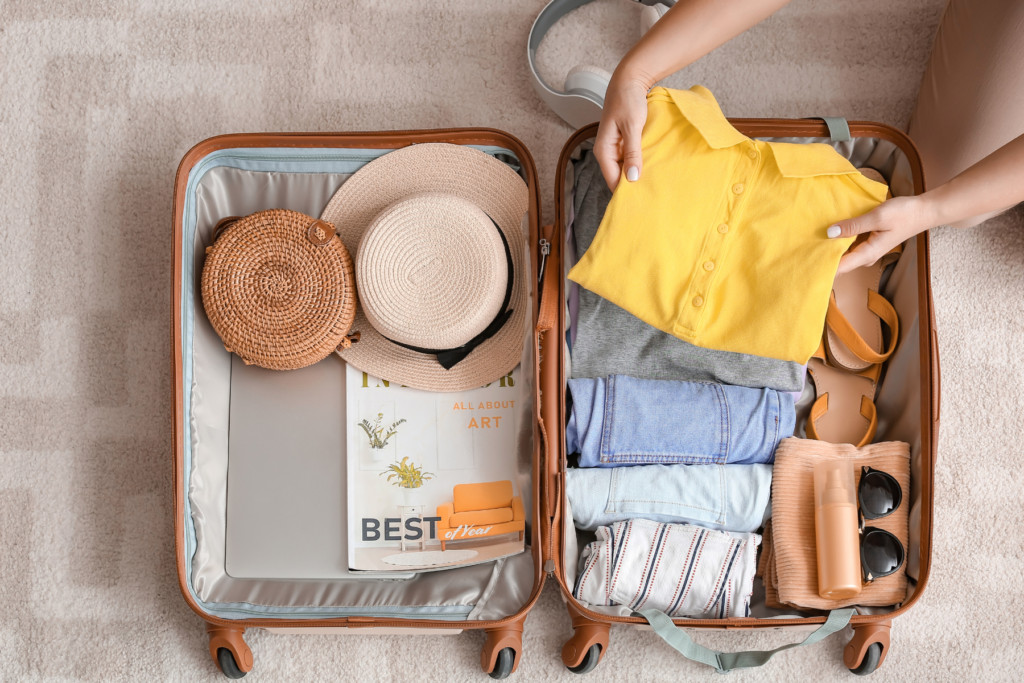 Person packing a small suitcase
Person packing a small suitcase
Step 13: Learn About Local Culture and Language
Enhance your travel experience by learning about the local culture and language of your destination. Cultural awareness and basic language skills can significantly enrich your interactions with locals and deepen your understanding of the place you’re visiting.
Ways to learn about local culture and language:
- Research Local Customs: Read about local customs, etiquette, social norms, and traditions before your trip. Understanding cultural nuances shows respect and helps you navigate social situations appropriately.
- Learn Basic Phrases: Learn a few basic phrases in the local language, such as greetings, “please,” “thank you,” “excuse me,” and basic directions. Even a few words can be greatly appreciated by locals and enhance your interactions. Language learning apps like Duolingo or Memrise can be helpful.
- Explore Local Cuisine: Research local foods and drinks that are unique to your destination. Be adventurous and try local dishes. Consider taking a cooking class in your destination to learn more about local cuisine firsthand. We enjoyed a fantastic cooking class in Marrakech and learned so much about Moroccan food.
- Read Local Literature and Media: Read books, articles, or watch movies set in your destination to gain cultural insights. Follow local news outlets or blogs to understand current events and perspectives.
- Engage with Locals Respectfully: Be open to interacting with locals, ask questions respectfully, and show genuine interest in their culture and way of life.
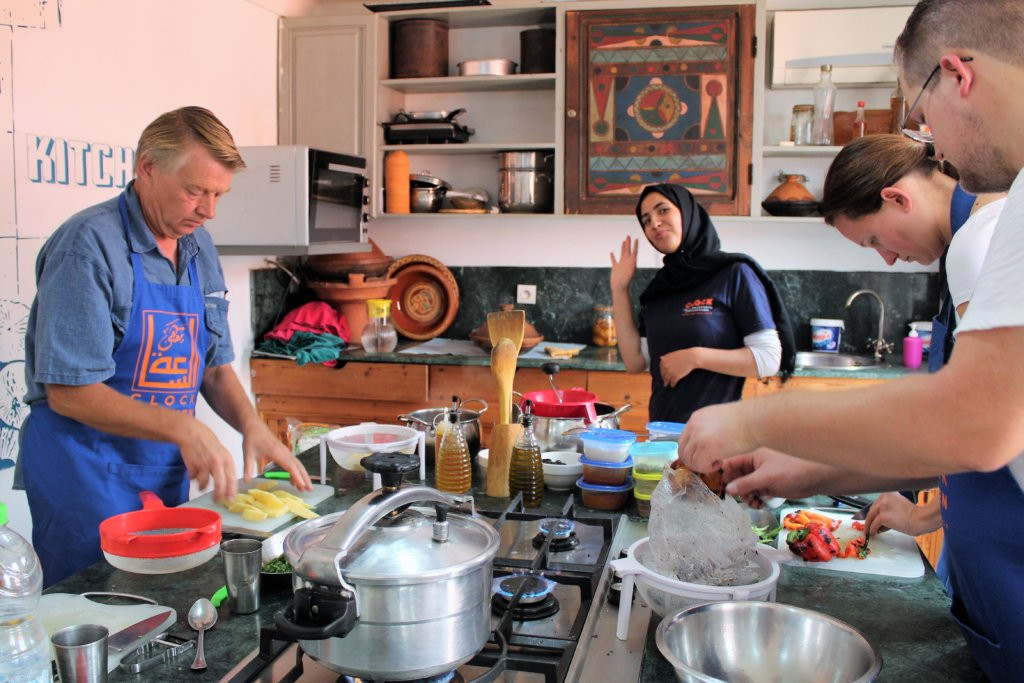 Person prepping vegetables during a cooking class in Marrakech
Person prepping vegetables during a cooking class in Marrakech
Step 14: Prepare Your Home for Your Absence
Before leaving for your trip, take steps to prepare your home for your absence, especially if you’ll be away for an extended period. Home preparation ensures security, safety, and peace of mind while you’re travelling.
Home preparation checklist:
- Arrange Pet and Plant Care: If you have pets or plants, make arrangements for their care. Hire a pet sitter, ask a friend or neighbor to care for your pets, or arrange for plant watering.
- Stop Mail and Deliveries: Halt mail and newspaper deliveries to prevent accumulation while you’re away. You can usually request a temporary hold from your postal service.
- Secure Your Home: Ensure all doors and windows are securely locked. Activate your home security system if you have one.
- Adjust Thermostat and Appliances: Adjust your thermostat to conserve energy while you’re away. Unplug unnecessary appliances to save energy and reduce fire risk.
- Inform Neighbors or Family: Inform a trusted neighbor or family member that you’ll be away and provide them with contact information in case of emergencies. Ask them to keep an eye on your property. You could suggest they occasionally park their car in your driveway to give the impression that your home is occupied.
- Set Timers for Lights: Use timers to switch lights on and off at intervals to simulate occupancy, especially during evenings.
Step 15: Finalize and Confirm Travel Details
The final stage of trip planning is to finalize and confirm all your bookings and travel details. Double-checking everything ensures a smooth departure and avoids last-minute surprises.
Final confirmation checklist:
- Review Bookings: Re-confirm all your flight, accommodation, tour, car rental, and other bookings. Check dates, times, locations, and names are correct.
- Gather Travel Documents: Collect all necessary travel documents, including passports, visas, flight tickets, accommodation confirmations, tour vouchers, travel insurance policy, and any required health documents.
- Make Copies of Documents: Make photocopies or digital copies of your passport, visa, insurance policies, itinerary, and other important documents. Store copies separately from originals, and leave a set of copies with a trusted person at home.
- Inform Your Bank: Notify your bank and credit card providers of your travel dates and destinations to avoid any issues with card usage abroad.
- Check Mobile Roaming and Data: Understand your mobile roaming and data charges for your destination. Consider purchasing a local SIM card or international roaming package if needed.
- Download Offline Maps and Language Apps: Download offline maps of your destination (e.g., Google Maps offline areas) and any language translation apps you might use.
Step 16: Enjoy Your Travel Adventure!
Congratulations! You’ve completed the trip planning process. Now, it’s time to relax and enjoy the adventure you’ve meticulously planned. The day you’ve been anticipating has finally arrived.
Remember to remain flexible during your trip. Unexpected events can occur, and plans might need adjustments. Embrace spontaneity, be open to new experiences, and savor every moment of your journey. Travel is about discovery, enjoyment, and creating lasting memories.
By following these steps on how to plan travelling, you’ll be well-prepared to create a trip that is not only memorable but also stress-free and enjoyable.
If you have any comments or additional trip planning tips to share, please feel free to email me – I always appreciate hearing from readers!
 Bon Voyage image
Bon Voyage image
Happy travels!
